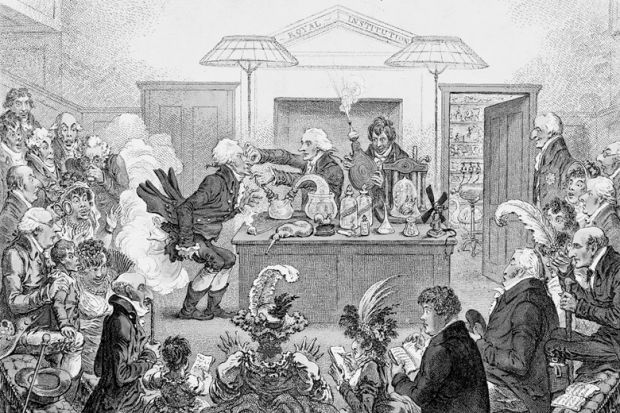Sir Humphry Davy (1778-1829) was a scientist, a showman and a celebrity. In his twenties, he gave popular lectures on chemistry at the newly opened Royal Institution of Great Britain in London to audiences of more than 1,000. There were many women in attendance, some of whom took notes while the men (allegedly) slept or took snuff. He established a high-powered research laboratory, where he discovered sodium, potassium and five other elements, and subsequently developed the miners’ safety lamp that bears his name.
Jan Golinski’s biography of Davy is explicitly not comprehensive, although it includes many of the salient details of Davy’s life and work. It seeks to tell us how, in an experiment that lasted throughout his life, he constructed and reconstructed himself. It is an approach that one might expect to bear fruit, as Davy doubtless refined his public persona continually, as successful showmen do.
Golinski’s focus is on Davy as enthusiast, genius, dandy, discoverer, philosopher and traveller – although of these only dandy, discoverer and traveller are used with their modern everyday meanings. His great enthusiasm was for using himself as an experimental subject. While working at Bristol’s Medical Pneumatic Institute before moving to London, he conducted experiments in which he and others ingested nitrous oxide and recorded the results. Davy appeared to consider genius as “a kind of spirit that came from outside oneself, one is possessed by it”. He aspired to be considered a philosopher, in recognition of his skill as a chemist with theoretical knowledge that was relevant to many practical activities. At the time, it was considered important that the philosopher – lucky chap – should be detached from the cares of the everyday world. Davy as traveller is in many ways the most interesting incarnation described in this book. His posthumously published work Consolations in Travel became the most successful of his books. Of its reflections on life, religion, the universe and everything, via a mix of poetry, autobiographical sketches and accounts of dreams, it is still not clear which of its various characters most accurately represents its author’s own views.
However, this thematic approach to biography can be frustrating for the reader because of what is left unaddressed. One of the most interesting questions about Davy’s life is why three very eminent men chose him, aged 23 and a relative unknown, to fill a prestigious post at the Royal Institution. What did they see in him that caused them to appoint him despite his youth and limited track record? This question is surely within Golinski’s self-defined brief, yet is not properly considered.
I have struggled to work out who will read this book. It seems too sketchy for anyone not reasonably familiar with Davy’s life, and says too little about Davy’s science for those primarily interested in his research. Its appeal will probably be greatest to social historians of the early 19th century. Golinski has limited admiration for his subject, and inter alia he notes Davy’s failure to train students or write a decent textbook, his social climbing and his reliance on patronage. He is critical of Davy’s attempts to occupy the moral high ground, particularly in regard to the invention of the miners’ safety lamp. At the very end he relents a little, describing Davy in a phrase taken from Consolations in Travel as “a perfect animal of a peculiar species”. But aren’t we all?
Richard Joyner is emeritus professor of chemistry, Nottingham Trent University.
The Experimental Self: Humphry Davy and the Making of a Man of Science
By Jan Golinski
University of Chicago Press, 256pp, £21.00
ISBN 9780226351360
Published 11 May 2016

